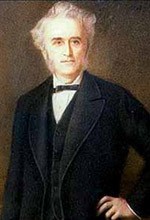
The first phenotypic descriptions of trisomy 21 disorder were made by the French Jean-Etienne-Dominique Esquirol in 1838 and Edourad Seguin in 1846.
But due to the great contributions made by the doctor Jhon Langdon Haydon Down, who dedicated part of his life to caring for patients who suffered with the genetic abnormality on chromosome 21 But it was not until 1965 when the WHO decided to name this genetic disorder as a syndrome Down.

Although this genetic alteration began to be studied in 1838, it was until 1959 when Jerome Lejuane, Marthe Gautier and Raymond Turpin discovered that Down syndrome responded to a genetic alteration due to a third chromosome 21, with this the first one was identified chromosomopathy. Down syndrome is a genetic disorder that originates when abnormal cell division produces an additional total or partial copy of chromosome 21. This additional genetic material causes changes in development and physical characteristics.
Down syndrome varies in severity from one individual to another, causing intellectual disability and lifelong delays in development. It is the genetic chromosomal disorder and the most frequent cause of learning disabilities in children. It also often causes other medical abnormalities, such as digestive and cardiac disorders.
Trisomy 21. In approximately 95 percent of cases, Down syndrome originates from trisomy 21: the person has three copies of chromosome 21 instead of the usual two copies, in all cells. This happens due to abnormal cell division during the development of the sperm or egg.
Mosaic Down syndrome. In this rare form of Down syndrome, only a few cells in the person have an additional copy of chromosome 21. This mosaic of normal and abnormal cells occurs through abnormal cell division after fertilization.
Down syndrome by translocation. Down syndrome can also occur when part of chromosome 21 binds (translocates) to another chromosome, before or during conception. These children have the usual two copies of chromosome 21, but they also have additional genetic material from chromosome 21 attached to another chromosome.
At Irega-Genetic we have the necessary tools to carry out a pre-implantation test to detect abnormalities on chromosome 21, so that in this way the probability of achieving a successful pregnancy can be increased.
Bibliography
Dr. Francisco Cammarata-Scalisi, Dra. Gloria Da Silva, Lic. Graciela Cammarata-Scalisi, Lic. Adalgisa Sifuentes C. History of Down syndrome. A count full of protagonists Roubertoux PL, Kerdelhué B. Trisomy 21: from chromosomes to mental retardation. Behav Genet 2006; 36: 346-54. Down JHL. Observation on an ethnic classification of idiots. London Hosp Rep 1866; 3: 259-62. Ward OC. John Langdon Down: the man and the message. Down syndr Res Pract 1999; 6: 19-24 FacebookTwitterEmailShare
